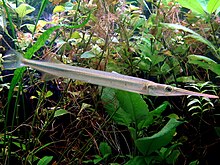Xenentodon cancila
| Xenentodon cancila | |
|---|---|

| |
| Scientific classification | |
| Domain: | Eukaryota |
| Kingdom: | Animalia |
| Phylum: | Chordata |
| Class: | Actinopterygii |
| Order: | Beloniformes |
| Family: | Belonidae |
| Genus: | Xenentodon |
| Species: | X. cancila
|
| Binomial name | |
| Xenentodon cancila (F. Hamilton, 1822)
| |
| Synonyms | |
| |
Xenentodon cancila, the freshwater garfish, is a species of
Common names

As a reasonably popular
Distribution
The freshwater garfish is widely distributed across South and Southeast Asia from India and
Morphology
In common with other needlefish, this species has an elongate body with long, beak-like jaws filled with teeth.[6] The dorsal and anal fins are positioned far back along the body close to the tail.[6] The body is silvery-green, darker above and lighter below with a dark band running horizontally along the flank.[2] Slight sexual dimorphism exists, the male fish often having anal and dorsal fins with a black edge.[4][6] It reaches a length of 40 cm (16 in).[2]
Diet
While aquarium books tend to describe this fish as a
Reproduction
This species is
Human significance
Freshwater needlefish support minor fisheries and are also traded as aquarium fish.[2]
In the aquarium
The freshwater needlefish is one of several of needlefish species kept in public and home aquaria.[6] It has been kept by European aquarists since 1910,[6] and was first bred in captivity at the Biological Station Wilhelminenberg, Austria in 1963.[4] Xenentodon cancila is generally considered quite a difficult species to maintain because of its large size, nervous behaviour, and preference for live foods.[3] Alongside misunderstandings of the natural diet of these fish,[7] there has been confusion over the optimal water conditions required by this species when kept in home aquaria, with the addition of salt to the water often being recommended.[5] These fish do perfectly well in freshwater aquaria.[7]
See also
References
- . Retrieved 20 November 2021.
- ^ a b c d Froese, Rainer; Pauly, Daniel (eds.) (2013). "Xenentodon cancila" in FishBase. May 2013 version.
- ^ a b c Monks N: Straight to the point: the Beloniformes. Practical Fishkeeping, October 2005
- ^ ISBN 3-88244-050-3.
- ^ )
- ^ a b c d e f Sterba, G (1962). Freshwater Fishes of the World. Vista Books. p. 609pp.
- ^ a b Monks N: Pocket-sized Pikes. Tropical Fish Hobbyist, April 2007

